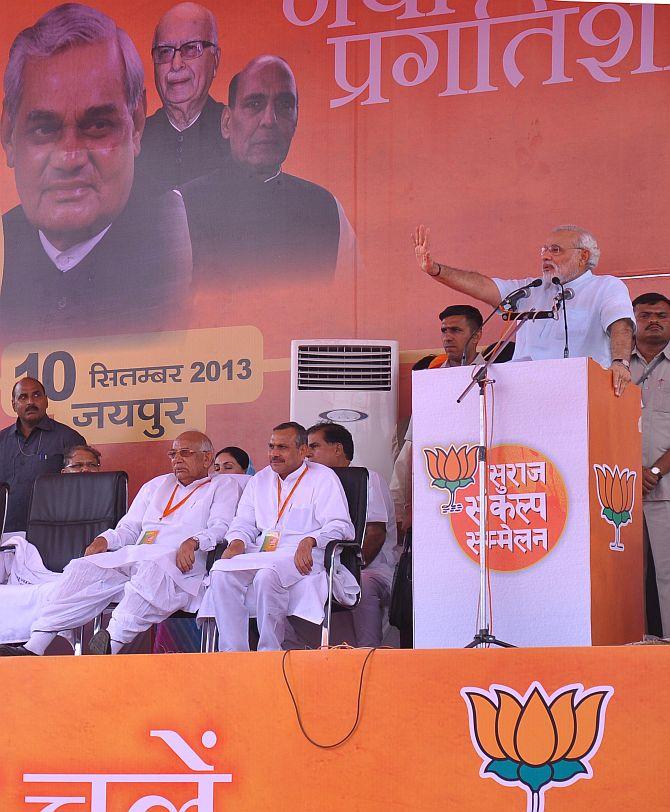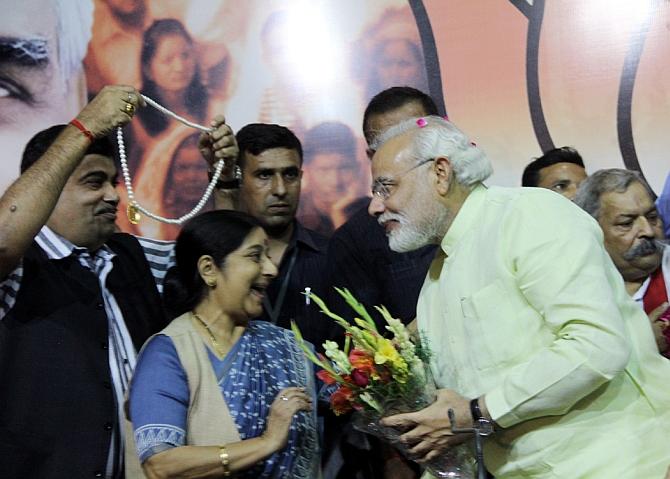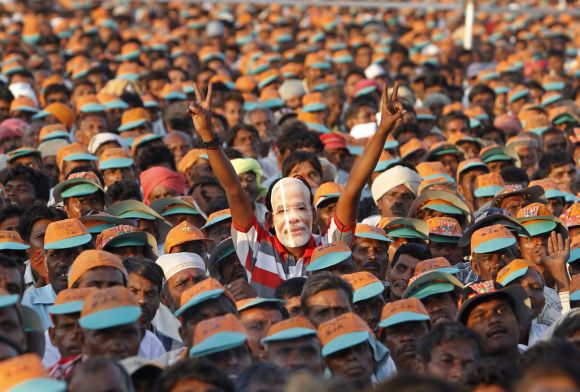
With just a two to three per cent increase in its vote share from 2009, the Bharatiya Janata Party might inch closer to the magical 180 seats, says Shreekant Sambrani
Except perhaps to visually and aurally challenged visitors from Krypton, the announcement of Gujarat Chief Minister Narendra Modi being the prime-ministerial candidate for the Bharatiya Janata Party should not be a surprise.
The claim of senior BJP leader L K Advani that the announcement may be premature and could be potentially damaging to the party is entirely disingenuous since it contests what has been a foregone conclusion for some time now.
The BJP rank and file as well as most of its leadership is convinced that fighting the 2014 general elections under Modi’s leadership is its best bet to come to power after a decade despite its acrimonious break with its ally of 17 years, the Janata Dal-United over the issue three months back.
...

Media pundits are not convinced. Most contend that even under Modi, the BJP may not cross the Rubicon. They are backed by various polls in the last three months that give the party no more than 150 to 160 seats, even as the BJP believes that it will get 200-plus seats on its own. I have doubted this, but from a slightly different angle.
The BJP has little presence in 180 constituencies. So, it must get 180-plus, which is the new 273, from the remaining 360-odd. That seems well-nigh impossible. The noted political scientist Ashutosh Varshney uses the share of popular vote to arrive at a similar conclusion.
These arguments are based on an extrapolation of the past. Therein lies their major flaw. Even those who are fans of neither the BJP nor Modi would have to accept that a realistic assessment of the current political ground reality shows a point of inflection. That changes the electoral arithmetic considerably.
The BJP is now at its Indira Gandhi moment, following a similar pattern as the Congress had. The Indian National Congress was formed as a political party out of diverse groups advocating sundry causes against British colonial rule. A 100 years later, in the early 1990s, the BJP became a true political unit. The Congress saw its raison d’être as the inheritor of the freedom movement, while the BJP did so as the champion of Hindu nationalism.
Gradually, as the Congress became used to being the party of governance, its style of functioning and leadership evolved in sync with emerging conditions. The BJP came to power in various states, either by itself or in partnership with like-minded parties, throughout the last two decades and acquired a similar patina of a ruling formation. It continued to assert its adherence to Hindu “culture,” but realised that that song had begun to play out.
...

The first BJP national leadership was remarkably similar to the Nehru cabinet: earnest, competent people, fairly conservative in their orientation and learned in ways of the world. They made a show of their religiosity, but so did most Congresspersons of the first post-Independence generation.
The passing of that BJP generation was sealed in the June Goa meeting. The second generation is again not unlike its counterparts in other parties, notably the Congress. The Rashtriya Swayamsevak Sangh may call the shots, but is mostly behind the scenes and the BJP conclaves appear and act no different from those of the Congress.
Modi is the most popular and visible BJP leader. Every poll has him at the pole position in the national sweepstakes. This may not be a cause for celebration, but one ignores the reality at the cost of being delusional.
His rise is strikingly similar to that of Indira Gandhi. They both began hesitantly, being thrust into office. Their godfathers, Kamraj for Gandhi and Advani for Modi, boosted their early careers. Soon, they learnt that they could appeal to the people directly. Just as quickly, their inherent authoritarianism made them larger than their parties. They no longer needed their mentors. Indira Gandhi lost no time in consigning the Congress Syndicate to the dustbin of history, as depicted in a memorable cartoon by R K Lakshman. Modi has done the same with Advani.
The first Congress split in 1967 posed no threat to Indira Gandhi, because of her popularity with the masses and her own unshakable faith in her destiny. The 1971 election became a referendum on her. The 2014 election appears to be headed the same way with Modi as the sole issue.
India’s pioneering psephologist, E P W da Costa, had brilliantly explained how the Congress in the 1950s and 1960s regularly won 60 per cent or more of the seats with less than 50 per cent of the popular vote. The anti-Congress vote being split among many candidates allowed the Congress to win without a majority of the popular vote. He devised an index of opposition unity to predict the number of Congress seats with a given vote share. The greater the opposition unity, the lesser the multiplier translating the Congress vote share into its seat share.
...

We now need a fracture index. The greater the disunity, the lower the share of popular vote sufficient to win the seat in our first-past-the-post system. In 2014, in major states such as Uttar Pradesh and Bihar, a 30-per cent vote share (or even slightly less) could win a seat. Also, in states where there would be bipolar contests -- Uttarakhand, Punjab, Himachal Pradesh, Rajasthan, Gujarat, Madhya Pradesh, Chhattisgarh, and even Maharashtra, together accounting for 175-plus seats -- it is advantage, BJP.
The 2009 BJP vote share of 18-plus per cent is below its natural share, closer to 20. So, it is possible (not necessarily either likely or desirable) that with just a two to three per cent increase in its vote, it might inch closer to the magical 180 seats. In fact, in 1999, the BJP vote share actually declined as compared to 1998, without affecting its seat tally. That was not as much due to alliances or the Vajpayee factors but directly because of the emotive issue of the just-concluded Kargil conflict.
Two other important determinants also have to be factored: first, the enormous power of the 24x7 media, as seen in the case of the Anna Hazare movement or the Delhi gang-rape. The other is Modi’s single-mindedness and tenacity, which he demonstrated in plenty in 2002 and 2007 elections (when everyone except this writer had written him off), almost like Mahendra Singh Dhoni’s ability to snatch improbable victories when defeat seemed all but certain in 2007, 2011 and 2013.
So, as the popular saying goes, it ain’t over ‘til the fat lady sings. She hasn’t even started clearing her throat yet!
The author taught at the Indian Institute of Management, Ahmedabad, and helped set up the Institute of Rural Management, Anand
...